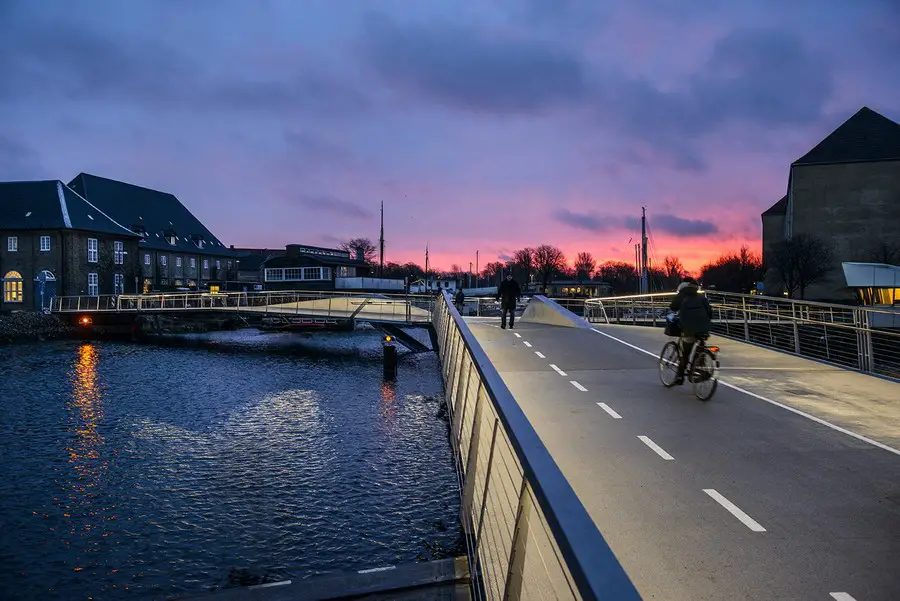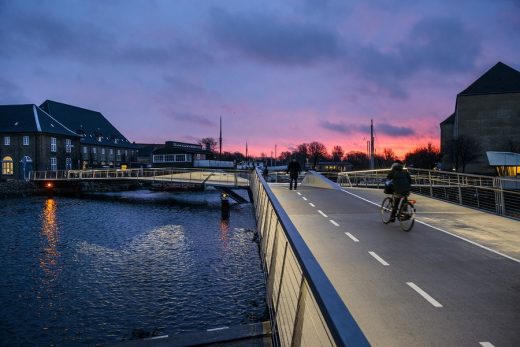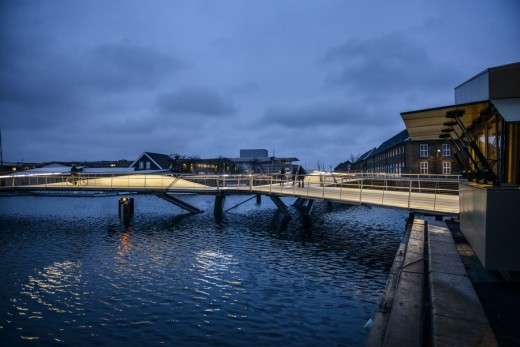Butterfly Bridge, Copenhagen Harbour Gateway, Dansk Arkitektur, Architecture Images Denmark
Butterfly Bridge in Copenhagen
Foot and Cyclebridge Christianshavns Kanal and Trangraven – design by Dietmar Feichtinger Architectes
7 Dec 2015
Butterfly Bridge in Copenhagen
Design: Dietmar Feichtinger Architectes
Location: Christianshavns Kanal / Trangraven, Copenhagen, Denmark
Butterfly Bridge Copenhagen
Bridges are places that offer new perspectives on the city, spectacular views of the water that reveal the cityscape. The bridges are elements that are part of the urban landscape in a natural way.
Butterfly Bridge in Copenhagen:
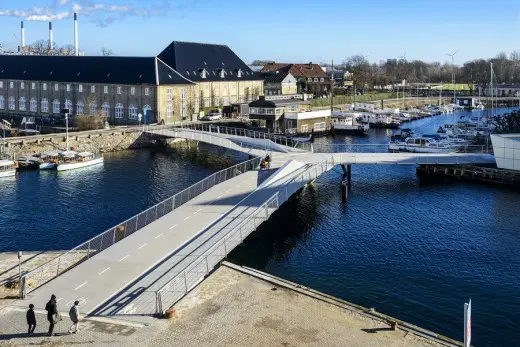
image : Christian Lindgren
Through their simplicities, they form a contrast with the monumental buildings. The bridges designated for pedestrians and cyclists offer a maximum of transparency and lightness.
The very specific situation demand an original form for this foot- and cycle bridge: Three decks connect the different banks. Fixed on a common platform, apron fixed the other two openings for passing sailboats. When both doors are open at the same time, they form a butterfly, a beautiful figure, which is spectacular for its size.
The link across Christianshavns Kanal and Trangraven is designed as three linear bridge spans that meet above the water’s surface in a star shape. The canal bridge design is adapted to the individual canal scenario.
Two of the spans can be opened independently of each other. When the moving spans are up they serve as barriers which means that the bridge always functions to and from Islands Plads.
The main structure of the steel bridge consists of a single-web, continuous T-beam. The beam web, which extends over the entire bridge, is built of a trapezoidal, for reasons of corrosion protection hermetically welded hollow section. The bridge deck is composed of an orthogonal anisotropic plate construction.
The moveable superstructure is formed of two individual bridge flaps. A counterweight to support the process of motion is not provided. The clear opening width is 15 m, the length from the pivot point to the flap tip is 23.3 m.
The width of the bridge cross-section is 7.9 m and the cross-sectional height varies at the bridge top from 0.5 m to 1.7 m at the junction of the cylinder with the superstructure.
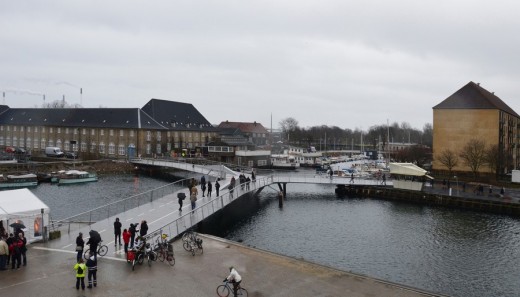
image : Barbara Feichtinger-Felber
The longitudinal beam widens from the axis of rotation starting at a width of 40 cm upwards in order to achieve the structural effective height of 1.7 m above the attachment point of the hydraulic cylinder. Towards the flap tip the construction height decreases again to pass to the standard cross-section.
The anchor point of the hydraulic cylinder is about 5 m from the axis of rotation. The axis of rotation and its support are part of the central pedestal. The hydraulic cylinders are stored on the pile cap of the center landing. When closed, the flap tip rests on the opposite shore-side bridge.
The structural system of the bridge flaps corresponds in a closed state to a single-span beam with a supportive structure which is restrained on one side (platform side) and pinned and supported on the other side (ramp to the shore). In an open state the bridge flap corresponds to a clamped cantilever.
The plate thicknesses have to be rated according to structural and constructional requirements. The hollow box is peripherally braced with an orthogonal system, consisting of longitudinal and transverse ribs:
– Longitudinal ribs of 150 mm – 200 mm high plates with a spacing of 400 mm
– Transverse beams of uninterrupted plates with a varying cross-section height of 500 mm in the cross-sectional center to 150 mm at the section edge.
At the respective ends of the movable bridge superstructure and at the column locations of the onshore connection ramp a rectangular hollow box is designed as an end cross beam.
The bridge is supported by elastomeric bearings and is brought into the correct position by a centering element in the middle in the process of movement. When closing the bridge two Oleo buffers are provided in addition to the elastomeric bearings.
The elastomeric bearing, the centering member and the buffers are mounted on a cantilever on the fixed part of the bridge.
The onshore connection corresponds to the standard cross-section with a span of 7.80 m and a cantilever of 2.60 m. On the water side the superstructure rests firmly connected on the V-steel columns couple.
The entire onshore connection is realized as a very light and removable design, so that in the event of a general overhaul of the existing shore walls and an envisaged widening of the road on the embankment beside the north abutment, the onshore ramp can be easily removed and modified.
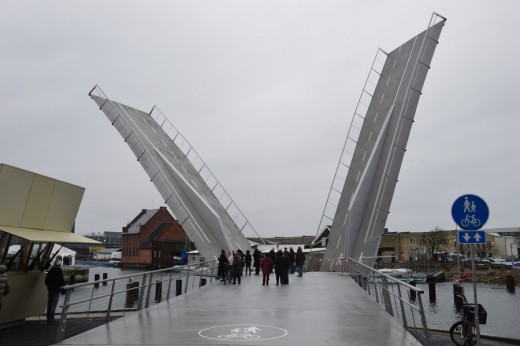
image : Barbara Feichtinger-Felber
Central platform with onshore connection
Two pivot axes and an onshore linkage are connected with the central platform. The rigid plate construction consists of the central webs of the bridge meeting in the middle and a peripheral edge support that holds the cross-sectional shape of the bridge. The edge support also has a hollow profile with a construction height of 60 cm. The onshore connection then corresponds to the rule profile of the superstructure. Directly below the axes of rotation, as well as under the bearing of the onshore connection, three pillar couples with V-shaped arranged columns are placed. Support and hydraulic cylinders are positioned on a common pile cap and thus form the fixed point of the bridge. The storage of the superstructure of the onshore connection to the abutment is made on elastomeric slide bearings.
Butterfly Bridge – Building Information
Project: Foot and Cyclebridges Christianshavns Kanal and Trangraven
Address: Copenhagen City Center
Client/Address: Københavns Kommune/City of Copenhagen
Architect: Dietmar Feichtinger Architectes
Team: Ulrike Gabriel and Guillaume Buton
Engineers: WTM ENGINEERS GMBH
Mechanical Engineers: SCHIPPKE
Size and main features
Total length: 63m
Length without access to podest: 43m
Length access to podest: 20m
Clear span: 24m
Length opening leaf: 24m
Width: 7.8m
Start of planning: Jul 2009
Start of construction: Mar 2012
Completion: Jan 2015
Building costs: 4.7M Euros
Butterfly Bridge in Copenhagen images / information received 071215
Location:Trangravsvej 1, København, Denmark
Copenhagen Buildings
Copenhagen Architecture Designs – chronological list
Steven Holl Architects : T-Husene
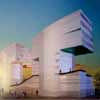
picture from architects
Copenhagen Harbour Gateway – Steven Holl Architects
Ørestad City housing – Plot Architects:
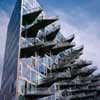
photo © Adrian Welch
Danish Architecture – Ny Havnen Arkitektur i København
Copenhagen Building News – Bridge Selection
Cirkelbroen Copenhagen : Olafur Eliasson
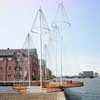
image : Olafur Eliasson
Copenhagen Bridge Competition : Studio Bednarski and Flint & Neill win
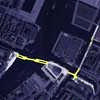
picture from architects
Comments / photos for the Butterfly Bridge in Copenhagen page welcome
Butterfly Bridge in Copenhagen – page
Website: Dietmar Feichtinger Architectes

